1993 BUICK LESABRE heater
[x] Cancel search: heaterPage 74 of 324
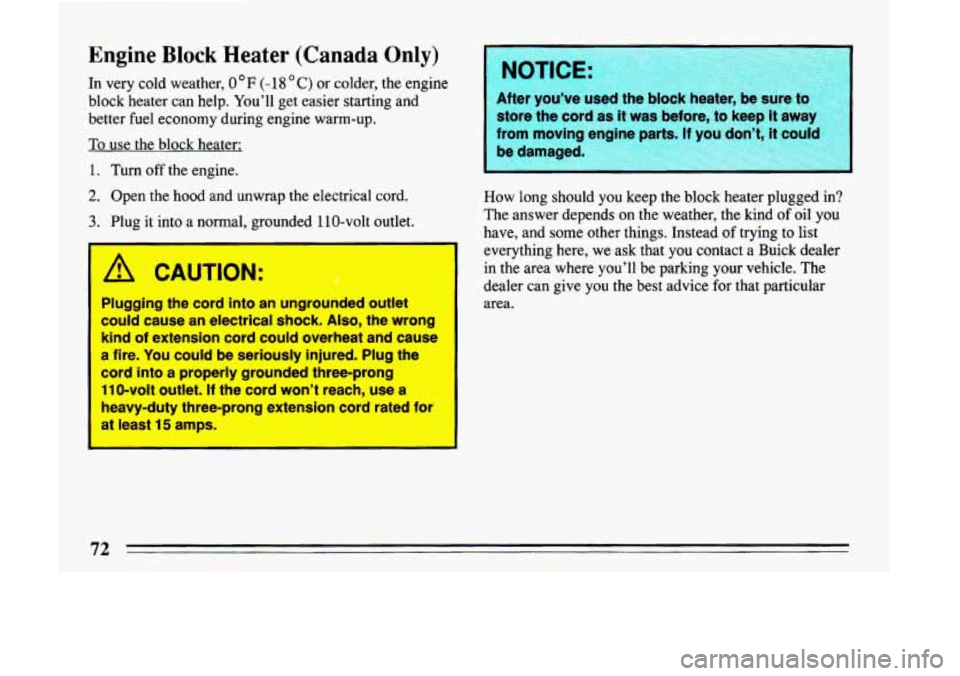
Engine Block Heater (Canada Only)
In very cold weather, 0 OF (- 18 C) or colder, the engine
block heater can help. You’ll get easier starting and
better fuel economy during engine warm-up.
To use the block heater:
1. Turn off the engine.
2. Open the hood and unwrap the electrical cord.
3. Plug it into a normal, grounded 110-volt outlet.
CAUTION: 0
Plugging the cord into an ungrounded outlet
could cause an electrical shock. Also, the wrong
kind
of extension cord could overheat and cause
a fire. You could be seriously injured. Plug the
cord into a properly grounded three-prong
110-volt outlet. If the cord won’t reach, use a
heavy-duty three-prong extension cord rated for
at least 15 amps. After you’ve
used the block heater, be sure to
store the
cord as it was before, to keep it away
from moving engine parts.
If you m’t, it could
be damaged
w1 ~
How long should you keep the block heater plugged in?
The answer depends on the weather,
the kind of oil you
have, and some other things. Instead
of trying to list
everything here,
we ask that you contact a Buick dealer
in the area where you’ll be parking your vehicle. The
dealer can give you the best advice for that particular
area.
Page 119 of 324

@ Part 3 Comfort Controls & Audio Systems
In this part you’ll find out how to operate the comfort control systems and audio systems offered with your Buick . Be
sure to read about the particular system supplied with your vehicle
.
Part 3 includes:
Comfort Control System
........................................................ 122
Heater and Defroster
....................................................... 123. 126
Airconditioner
........................................................... 119. 125
Rear Window Defogger
.................................................... 124. 127
Ventilation
................................................................... 126
Audiosystems
.................................................................... 127
Settingtheclock
................................................. 130. 132. 134. 137
RadioControls
....................................................... 129. 130. 133
TapePlayerControls
................................................... 132. 134. 136
CDPlayerControls
............................................................ 138
Understanding Radio Reception .................................................. 127
CareofCompactDiscs
......................................................... 142
Antennacare
................................................................ 142
Care
of Cassette
Tape Player & Tapes ............................................. 141
117
-
Page 126 of 324
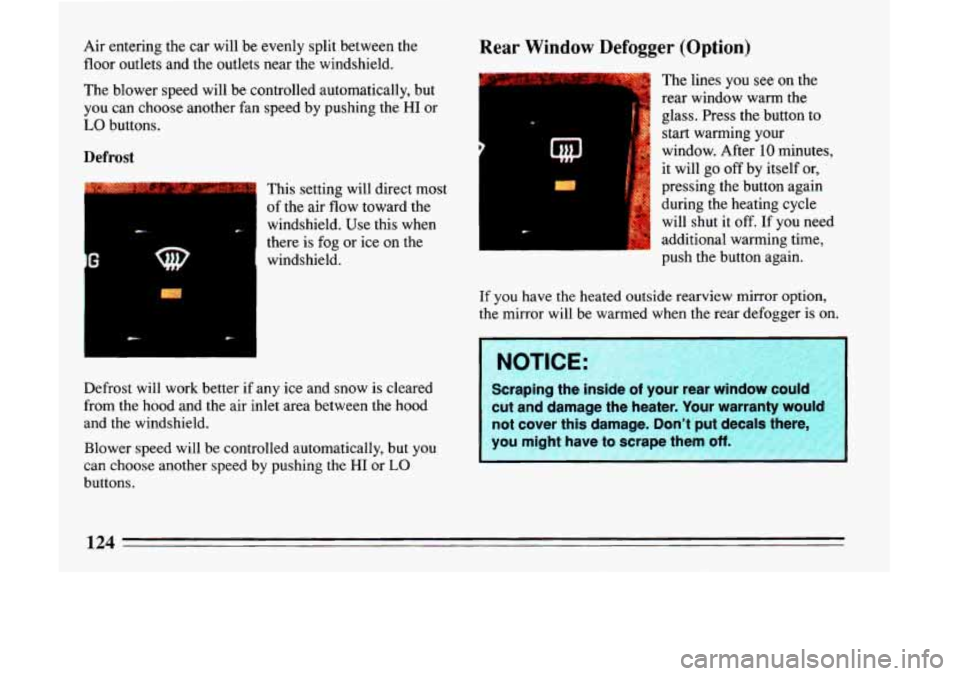
Air entering the car will be evenly split between the
floor outlets and
the outlets near the windshield.
The blower speed will be controlled automatically,
but
you can choose another fan speed by pushing the HI or
LO buttons.
Defrost
This setting will direct most
of the air flow toward the
windshield. Use this when
there is fog or ice on the
I windshield.
Defrost will work better if any ice and snow is cleared
from the hood and the air inlet area between
the hood
and
the windshield.
Blower speed will be controlled automatically, but
you
can choose another speed by pushing the HI or LO
buttons.
Rear Window Defogger (Option)
The lines you see on the
rear window warm the
glass. Press the button to
start warming your
window. After
10 minutes,
it will go
off by itself or,
pressing the button again
during the heating cycle
will shut it
off. If you need
additional warming time,
push the button again.
If you have the heated outside rearview mirror option,
the mirror will be warmed when the rear defogger is on.
I NOTICE:
Scraping the inside of your rear winoow could
cut and damage the heater. Your warranty wou’” not cover this damage. Don’t put decal? +here,
you might have to scrape them off.
Page 127 of 324

If your Buick has this climate control system, the
following information tells you how it works.
Your Buick's flow through ventilation system supplies
outside air into
the vehicle when it is moving. When the
heater or air conditioning fan is running, outside air
will
also enter the vehicle.
Fan Speeds
The fan control is used to select the speed you want the
blower to control the air flow.
Lever Controls
The upper lever changes the fan speeds. The lower lever
changes the temperature
of the air coming through your
air outlets.
Air Conditioning
The next three selections cool the air. The air
conditioner won't work well unless all the windows are
closed. On very hot days, open the windows long
enough
to let hot inside air out. This reduces the amount
of work your air conditioner's compressor will have to
do, which should help fuel economy.
Max
This setting provides maximum cooling with the least
amount of work.
MAX recirculates much of the air
inside your vehicle
so it maximizes your air
conditioner's performance and fuel economy.
Norm
Use NORM for normal cooling on hot days. This setting
cools outside air and directs it through the instrument
panel outlets.
125
Page 128 of 324
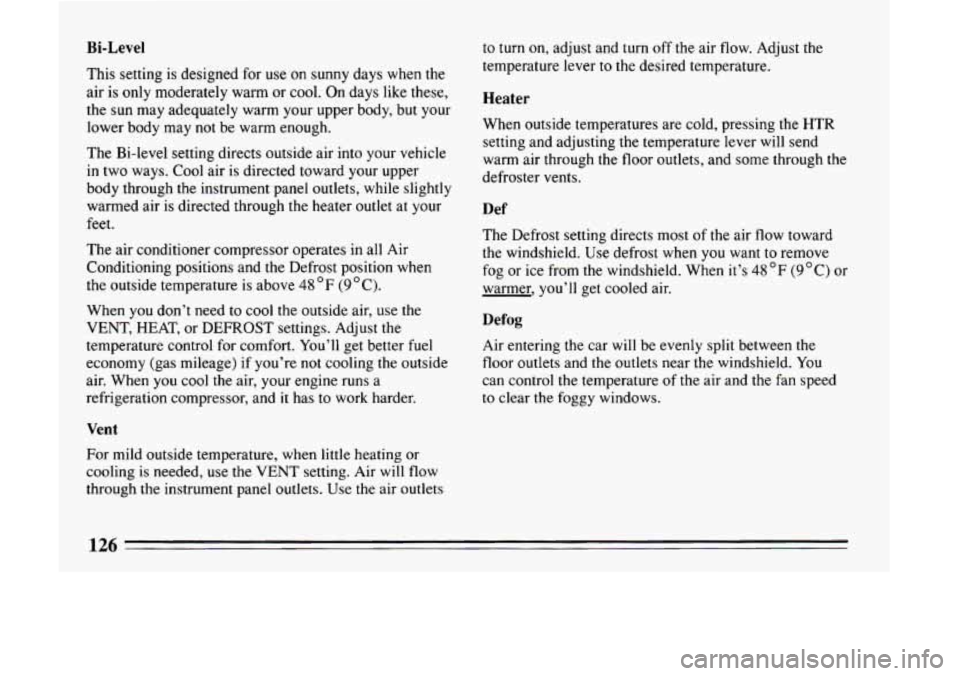
Bi-Level
This setting is designed for use on sunny days when the
air is only moderately warm or
cool. On days like these,
the sun may adequately warm your upper body, but your
lower body may
not be warm enough.
The Bi-level setting directs outside air into your vehicle
in two ways. Cool air is directed toward your upper
body through the instrument panel outlets, while slightly
warmed air is directed through the heater outlet at your
feet.
The air conditioner compressor operates in all Air
Conditioning positions and the Defrost position when
the outside temperature is above
48 OF (9OC).
When you don’t need to cool the outside air, use the
VENT, HEAT, or DEFROST settings. Adjust the
temperature control for comfort. You’ll get better fuel
economy (gas mileage) if you’re
not cooling the outside
air. When
you cool the air, your engine runs a
refrigeration compressor, and it has to work harder.
Vent
For mild outside temperature, when little heating or
cooling is needed, use the
VENT setting. Air will flow
through the instrument panel outlets. Use
the air outlets to
turn on, adjust and turn
off the air flow. Adjust the
temperature lever to the desired temperature.
Heater
When outside temperatures are cold, pressing the HTR
setting and adjusting the temperature lever
will send
warm air through the floor outlets, and some through the
defroster vents.
Def
The Defrost setting directs most of the air flow toward
the windshield. Use defrost when
you want to remove
fog or ice from
the windshield. When it’s 48 OF (9 “C) or
warmer, you’ll get cooled air.
Defog
Air entering the car will be evenly split between the
floor outlets and the outlets near the windshield. You
can control the temperature of the air and the fan speed
to clear the foggy windows.
126
Page 129 of 324
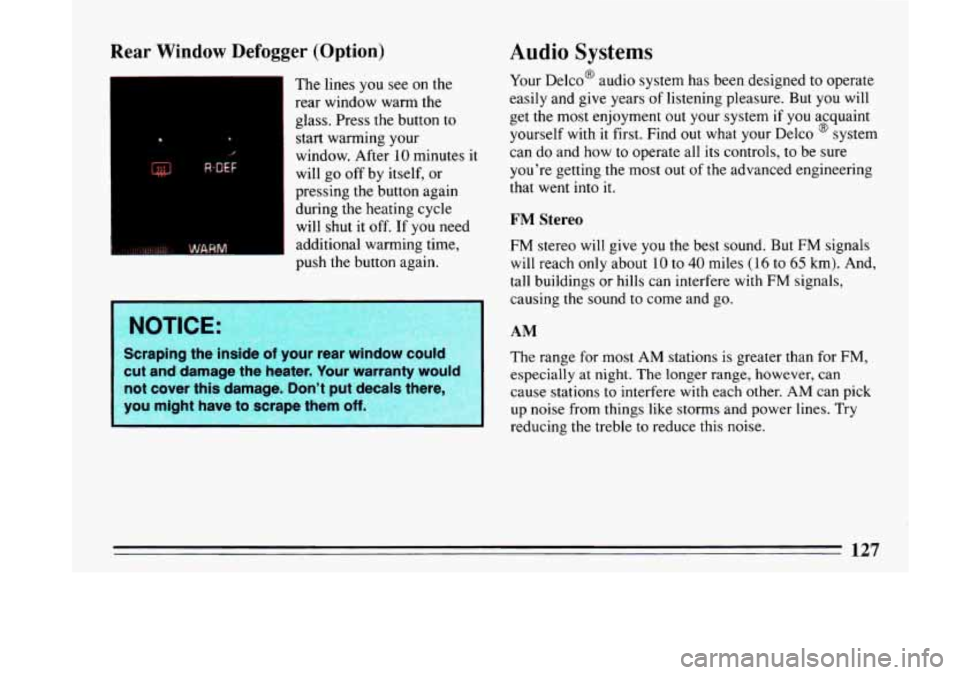
Rear Window Defogger (Option)
The lines you see on the
rear window warm the
glass. Press the button to
start warming your
1 window. After-10 minutes it
will go off by itself, or
pressing the button again
during the heating cycle will shut it off. If you need
additional warming time,
push the button again.
Scraping the inside of your rear window could
cut and damage the heater. Your warranty would
not cover this damage. Don’t put decals there
you might have to scrape them
off.
Audio Systems
Your Delco@ audio system has been designed to operate
easily and give years
of listening pleasure. But you will
get the most enjoyment out your system if you acquaint
yourself with it first. Find
out what your Delco @ system
can do and how
to operate all its controls, to be sure
you’re getting the most out of the advanced engineering
that went into
it.
FM Stereo
FM stereo will give you the best sound. But FM signals
will reach only about
10 to 40 miles (16 to 65 km). And,
tall buildings or hills can interfere with
FM signals,
causing the sound to come and go.
AM
The range for most AM stations is greater than for FM,
especially at night. The longer range, however, can
cause stations to interfere with each other. AM can pick
up noise from things like storms and power lines. Try
reducing the treble
to reduce this noise.
Page 190 of 324
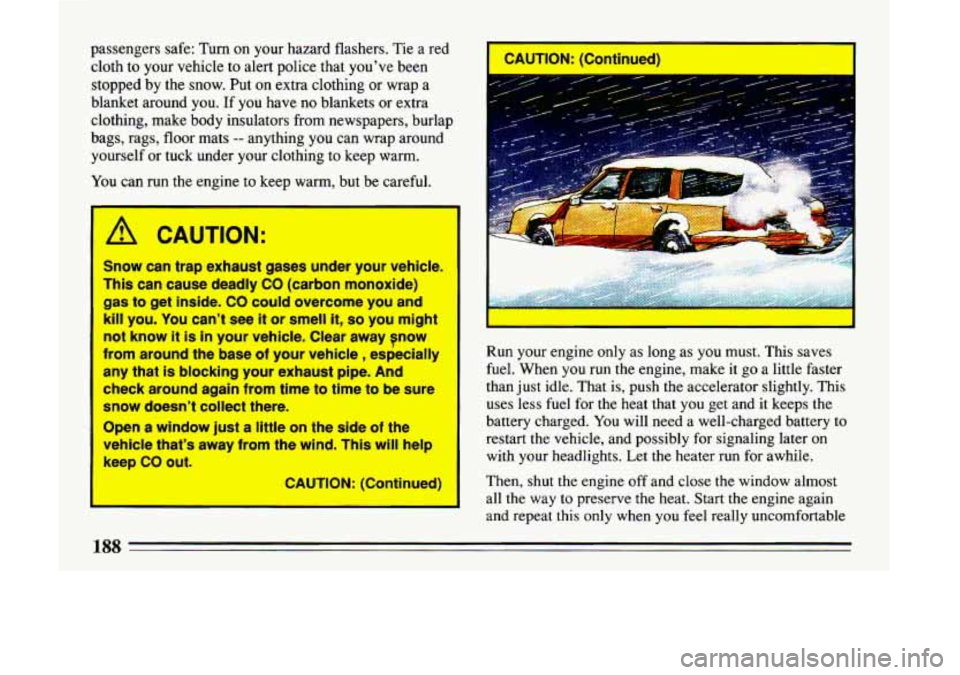
passengers safe: Turn on your hazard flashers. Tie a red
cloth to your vehicle to alert police that you’ve been
stopped
by the snow. Put on extra clothing or wrap a
blanket around you.
If you have no blankets or extra
clothing, make body insulators from newspapers, burlap
bags, rags, floor mats
-- anything you can wrap around
yourself or tuck under your clothing to keep warm.
You can run the engine to keep warm, but be careful.
CAUTION: (Continued)
-
4
I-
b, CAUTION:
Snow can trap exhaust gases under your vehicle.
Thls can cause deadly CO (carbon monoxlda)
gas to get inslde. Cb could overcome you and
kill you. You can’t see It or smell it, 50 you might
not know it is in your vehicle. Clear away pow
from around the base of your vehicle I especially
any that is blocking your exhaugt pipe. And
cbk around again from time to time to be sum
snow doesn’t collect them
Open
a window just a little on the slde of the
vehicle that’s away from the wind. This will help
keep CO out.
CAUTION: (Continued)
Run your engine only as long as you must. This saves
fuel. When you run the engine, make it go
a little faster
than just idle. That
is, push the accelerator slightly. This
uses less fuel for the heat that you get and it keeps the
battery charged.
You will need a well-charged battery to
restart the vehicle, and possibly for signaling later on
with your headlights. Let the heater run for awhile.
Then, shut the engine off and close the window almost
all the way to preserve the heat. Start the engine again
and repeat this only when you feel really uncomfortable
188
Page 210 of 324
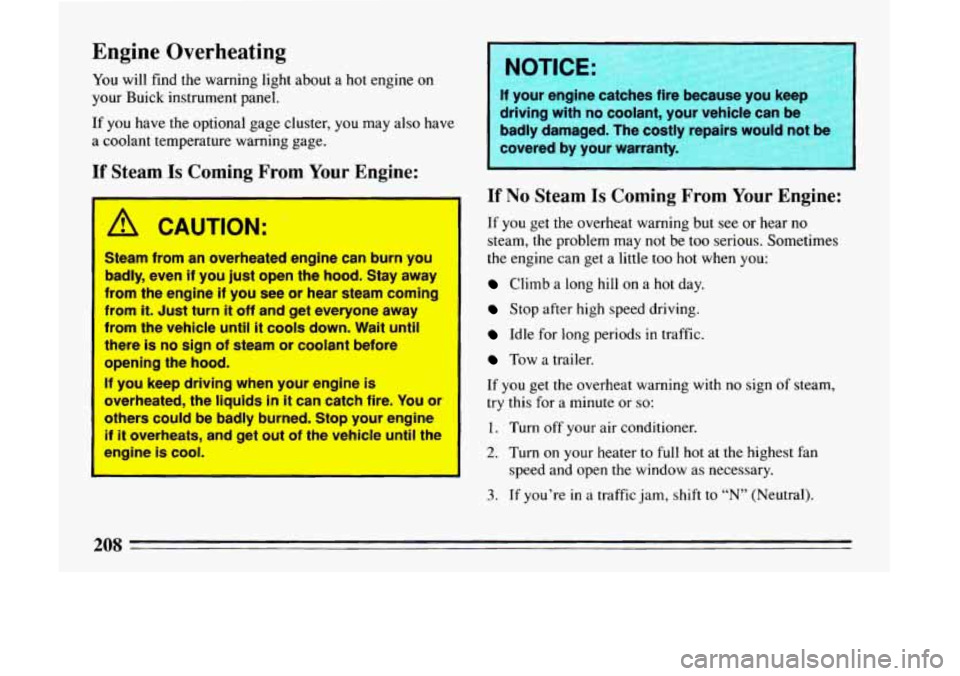
Engine Overheating
You will find the warning light about a hot engine on
your Buick instrument panel,
If you have the optional gage cluster, you may also have
a coolant temperature warning gage.
If Steam Is Coming From Your Engine:
CAUTION:
eam from an overheated engine can burn you
badly, even if you just open
the hood. Stay away
from
the engine if you see or hear steam coming
from
it. Just turn it off and get everyone away
From the vehicle until
it cools down. Wait until
there
is no sign of steam or coolant before
opening the hood.
If you keep driving when your engine is
overheated, the liquids in it can catch fire. You or
others could be badly burned. Stop your engine
if it overheats, and get out of the vehicle until the
engine is cool. badly
damaged. The costly
covered by your warranty.
If No Steam Is Coming From Your Engine:
If you get the overheat warning but see or hear no
steam, the problem may not be too serious. Sometimes
the engine can get a little too
hot when you:
Climb a long hill on a hot day.
Stop after high speed driving.
Idle for long periods in traffic.
Tow a trailer.
If you get the overheat warning with no sign of steam,
try this for a minute or so:
1. Turn off your air conditioner.
2. Turn on your heater to full hot at the highest fan
speed and open the window as necessary.
3. If you’re in a traffic jam, shift to “N” (Neutral).
208